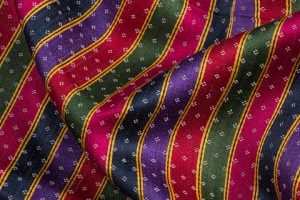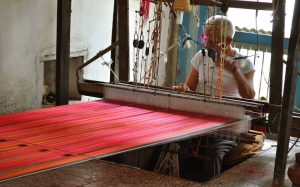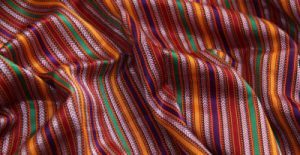The mashroo fabric has been woven in Kutch and Patan for many centuries. The word “mashroo” means “permitted” in Arabic and the craft has its origin in the prohibition By Islam on the use of silk. Mashroo is composed of a silk warp cotton weft. The ground material, which touches the skin is therefore cotton. The surface becomes smooth with the silk llater. Although mashroo was prevalent in other places, it survived as a craft only in Gujarat. Over the last couple of decades, silk has been changed to rayon because it’s more easily procurable and cheaper than silk. The mashroo fabric is woven in a pit loom and with bright colours. The width of the fabric is narrow. Skirts, blouses, tunics for men and women are other garments made from the fabric of mashroo.
Mashru fabric is a specialty of Gujarat. It exists in bright contrasting colors and is woven into many garments by the Kutchi community. which enlighten the sea of sand. The history of the textile revisits the traditional customs that were a part of the lifestyle of people living in Gujarat. It was originally worn by Muslim communities, who mixed the silk and cotton yarn to create this weaving style. This strategy was adopted as a solution to the aversion of wearing silk by the Muslim locals. Hence, weavers devised a solution where the lustre and softness of silk and transient comfort of cotton can be matched together for the locals in the Gujarat desert. The silk fabric appears to outside the garment while the cotton fabric is inside the garment. It makes mashru luxurious and imbues it with practical utility. The silk on the outer surface provides the gloss while the cotton in the back soak sweat and keep the wearer cool in the hot climate.







